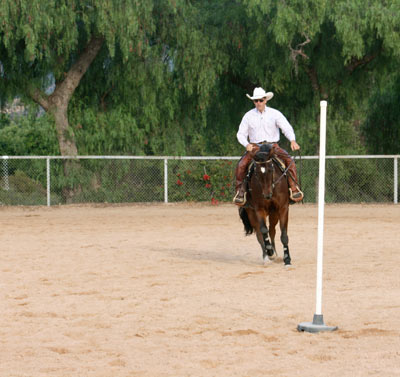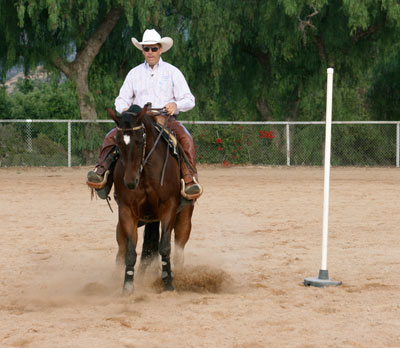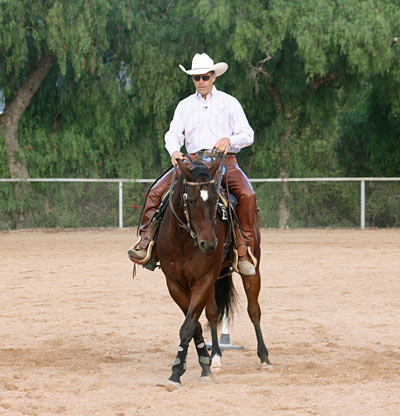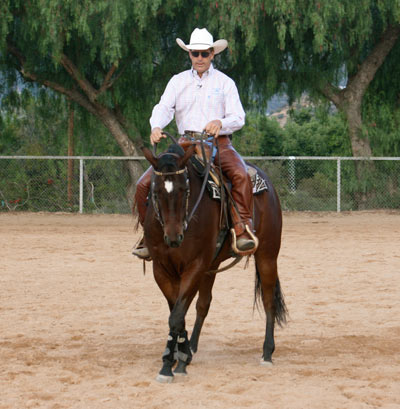|
Canter Departures With Richard Winters Horsemanship
In this article I’d like to discuss how you can improve the canter departs maneuver.
Canter depart is the term used to describe how well a horse picks up a canter or lope from a walk when asked to move out on a
particular lead. This maneuver is important for the reining horse because he must start the figure eight pattern loping off on the correct
lead while maintaining straightness and staying on course to begin the circles. It is also important for the western or English show horse
who must execute a canter departure while on the rail. Mastering the following exercise will bring refinement to your canter departures
and help you overcome some common problems riders have when attempting to lope off correctly.
I like to practice this exercise within the context of a figure eight. It’s beneficial to have some sort of marker designating the center of
your figure eight so that you can begin to ride with more accuracy. To receive the most benefit from this exercise you should also be
attempting to make symmetrical and even circles on both sides of the figure eight.
In this series of photos I will begin to lope circles to the right. The pole is my middle marker so that I stay even and on course.
 |
Photo 1) I begin to lope circles to the right. I’ll lope around as many times as is necessary so that my horse is relaxed and I’m making smooth balanced circles.
 |
Photo 2) As I approach the middle of my figure eight I will straighten my horse’s body for one to three strides and then ask my horse to
stop. It’s important to straighten his body so that he can stop more correctly. A bent, and or crooked horse never stops well.
 |
Photo 3) I will now leg yield my horse to the right into the direction I was traveling. In this leg yield I want my horse to move his
shoulders and hind quarters simultaneously, to the right, with his nose slightly counter bent to the left.
 |
Photo 4) Now, I will canter depart on my left lead and begin loping circles to the left on my figure-eight. After loping as many circles as
needed in the left circle, I will repeat the exercise in the middle by stopping straight, leg yielding to the left, and canter departing on the
right lead in my right hand circle. This could be repeated numerous times.
What are the benefits of this exercise?
1) You will begin to lope off on a particular lead without depending on a circle to help establish it. After you leg yield over - it’s
important to lope off on the new lead while traveling straight ahead. Don’t turn off into your new circle until the new lead is established.
2) You will begin to establish better shoulder control. Often times riders allow their horse’s to drop their shoulder into the direction of the lead and are unable to canter depart with straightness.
3) This exercise helps to correctly frame your horse as you depart into the lope. Photo 3 shows me leg yielding to the right in
preparation for a left lead canter departure. I have his shoulders up and straight and I can see the corner of this left eye as his body is
bent slightly to the left. Now, I’m in a good position to lope off on my left lead.
I have been referencing this exercise being executed while loping figure eight circles. It will help if you can envision figure D’s instead. In
figure D’s you will straighten your horse’s body as you approach the middle in preparation for the stop. Then you will continue to travel
straight, after the leg yield for a couple strides, and then reestablish the circle in the new direction. In this maneuver; the stop and canter
departure are executed on a straight line. This is critical to keeping correct form and body posture. This exercise is also a great precursor to flying lead changes.
Executing a proper canter departure demonstrates that we are riding with more accuracy, refinement, and body control. It always
comes back to body control when training the performance horse. Remember; body control is not the main thing. Body control is everything!
For more information about Richard Winters Horsemanship please go to wintersranch.com.
|